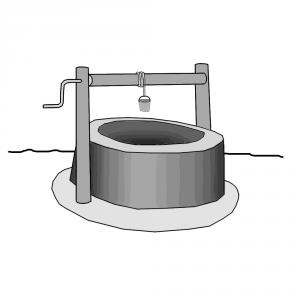The traditional and still most common method of obtaining groundwater in rural areas of the developing world is by means of hand-dug wells (WATERAID 2008). With the prior knowledge that groundwater is present and rather close to the surface, a hole is dug until the groundwater level is reached. Inflowing groundwater is collected and extracted with the help of pumps or buckets. Given suitable geological conditions, dug wells provide a low-tech solution to the challenges of rural water supply and can be implemented with a high level of community participation and locally available material and tools. They can provide a viable alternative to unhygienic, unprotected water sources while avoiding the investment and maintenance costs associated with more sophisticated water supply systems. However, supervision and careful operation and maintenance are important. Protection of the surrounding areas must be ensured to prevent contamination. Hence, capacity building on how to manage and use the system must be implemented.
| Entradas | Salidas |
|---|---|
Freshwater, Drinking Water |
The traditional and still most common method of obtaining water from groundwater sources in rural areas of the developing world is by means of hand-dug wells (WATERAID 2008).In contrast to surface water, groundwater is usually of higher water quality. Although technical equipment could support the construction of a dug well, excavation is mostly conducted manually as many rural regions offer cheap labour and lack adequate technical resources.
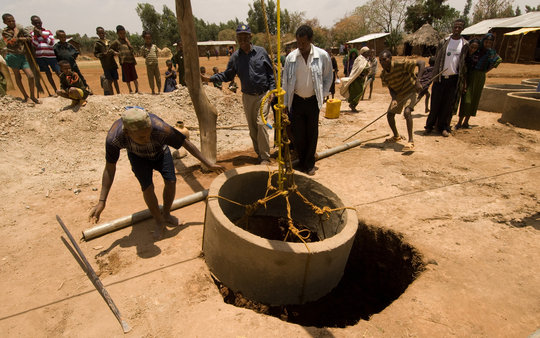
The basic principle is rather straightforward: With the prior knowledge that groundwater is present and close to the surface, a hole is dug until the groundwater level is reached. Inflowing groundwater is collected and can be extracted with the help of pumps or buckets (see also manual pumping and mechanised pumping). Depths of hand-dug wells range from shallow dug wells (about5 metres in depth) to deep dug wells (over 20 metres in depth). An excavation of about 1.5 metres in diameter provides adequate working space for the diggers and will allow a final internal diameter of about 1.2 metres after the well has been lined (WATERAID 2008). In some cultures, dug wells are more than 15 metres in diameter.
The performance of the well in terms of quantity is largely determined by the soil type (i.e. the porosity), by the diameter and depth of the well. Wells with a large diameter and depth expose a greater area for infiltration, and therefore provide fast recharge, e.g. an aquifer of 2 metres in depth and a well with 1.3 m diameter will expose 8.2 m2 for infiltration of water, while a 150 mm diameter drilled hole only exposes 1 m2 (COLLINS 2000).
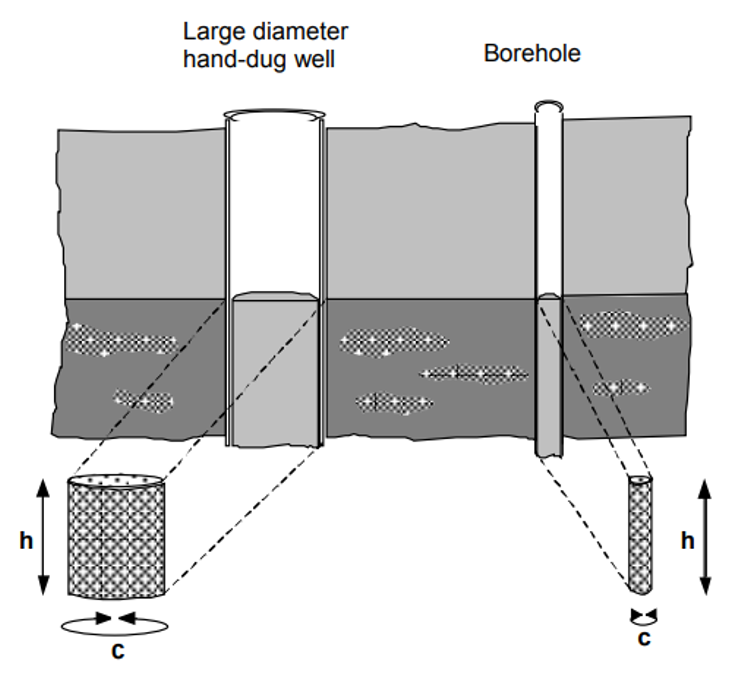
Initial Assessment
Before starting to design and develop any kind of water source, an initial assessment should be conducted in order to effectively and efficiently manage and develop water resources. This assessment includes a water balance estimation (i.e. the collection of hydrological data, determination of the current status and trends of water supply, an input-output-analysis, and a water and material flow analysis) and water resources assessment (i.e. the evaluation and systematic study of water resources in relation to human impact, e.g. demand evaluation, trend estimation, analysis of water use and quality). When analysing the demand side, water allocation issues play a vital role. Eventually, this assessment can lead to a water resources development plan describing the status, the management and future development of water resources in a particular area or watershed.
Prerequisites
Before constructing a dug well, geological suitability of the area, acceptance within the community and the capability of operating and maintaining the system have to be assessed.
A thorough investigation of the area should be conducted in order to determine (see also exploring tools and understand your system):
- The type of source and soil (must allow safe excavation)
- Existence of an aquifer. Alternatively, dry riverbeds may provide a water source during dry-season (cf. NISSEN-PETERSEN 1997).
- The level of the groundwater (deep enough: protection against contamination of groundwater; but not too deep: safety of excavation, high effort)
- The quantity of available water (also in the perspective of a long-term perspective); the future recharge potential
- The quality of the water
- The range of technically feasible options for the construction (see COLLINS (2000) for a complete list of criteria).
Villagers and members of the neighbouring communities can be a good source of information on the presence of shallow groundwater. Also, certain types of vegetation (e.g. banana plants, bulrushes, sugar cane, date palms) can indicate presence of groundwater (COLLINS 2000). Often, existing wells in close proximity indicate the presence of groundwater. If technical equipment is available, test borings can give detailed information on the groundwater level.
Elements of a Dug Well
A dug well consists of three major components (COLLINS 2000):
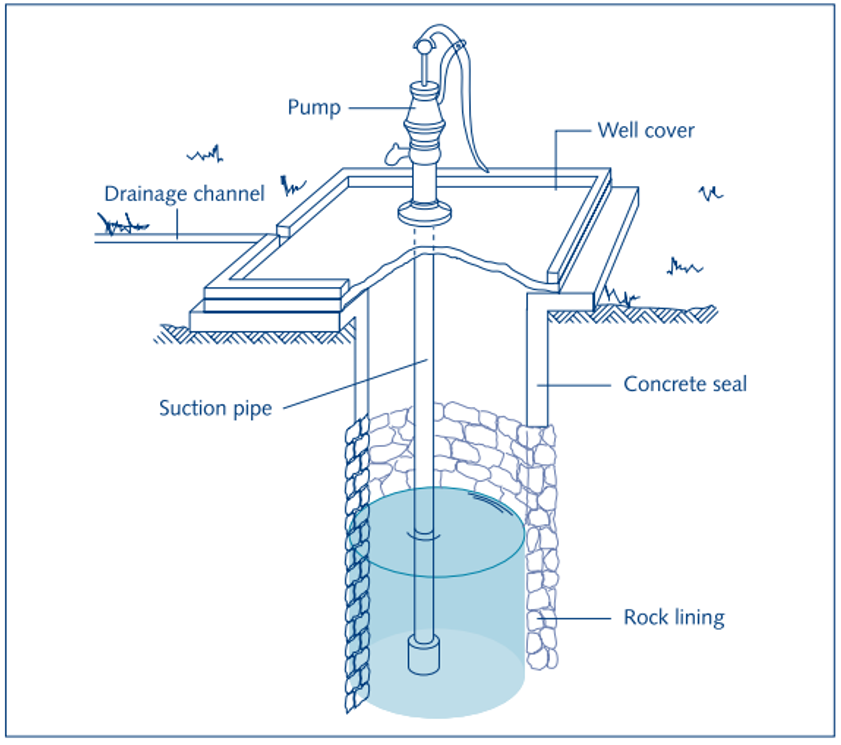
The well head: This is the part of the well, which is visible above the ground. It protects the well from contamination and generally consists of a well cover or apron, a concrete seal, a manhole (for access), a drainage channel and a pump.
- The well shaft: This is the section of the well between the head and the intake. It is made out of a strong, durable material, which can easily be kept clean.
- The intake: The walls of the intake are constructed in such a way as to allow water to pass from the aquifer into the well, thus creating a storage area, which can be accessed either by bucket or pump.
Construction
Under supervision, not skilled but physically capable workers are required in the whole construction process. During or after excavation, a permanent lining needs to be installed unless the well is constructed in consolidated ground (i.e. rock formations). The lining serves several purposes: During construction, it provides protection against caving and collapse and prevents crumbling ground from filling up the dug hole.
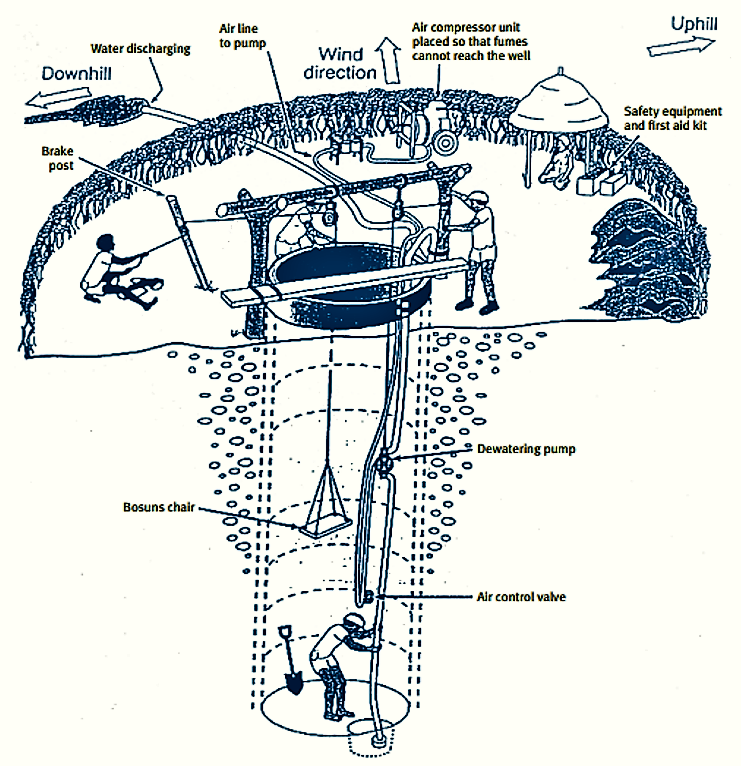
After completion of the well it retains the walls (SMET & WIJK 2002). Although a wide range of construction methods and materials (e.g. brick, stone, masonry, concrete cast in a shuttering inside the hole)can be used, most well programmes recommend the use of circular, precast concrete well "rings". They can be produced on-site or in a local production centre. In very soft formations, the rings are sunk starting from the surface: digging from the inside of the ring, removing the material with a bucket and adding new rings as required. In harder, semi-consolidated formations, the rings can also be inlaid after having excavated the hole completely until the groundwater level (UNICEF 1999).
Regardless of the method that has been used to excavate the well to the water table, excavation below this level should never be attempted until the sides of the excavation have received the support of a permanent lining. Excavation below the water table should be carried out within precast concrete caisson rings of a smaller diameter than the rest of the well (WATERAID 2008). In most cases, a motorised pump is required to dewater the well to allow excavation below the water table; however, in some cases, efficient hand pumps can also be applied successfully (UNICEF 1999).
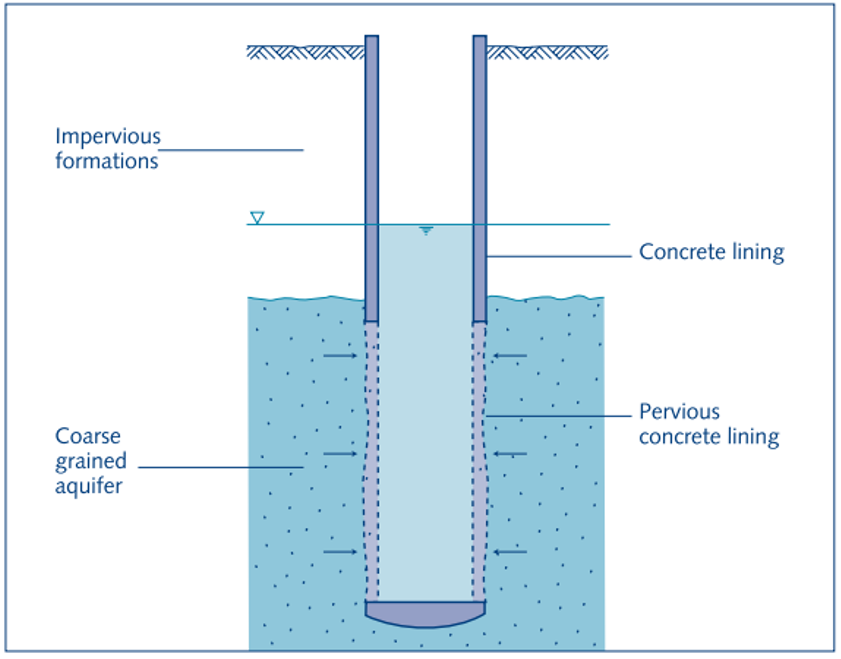
The section of the well penetrating the aquifer requires a lining with openings or perforations enabling the groundwater to flow into the well(SMET & WIJK2002). In formations with fine sand or silt particles, a filter at the bottom of the finished well is often necessary to prevent particles to enter and clog the well. Usually, the filter is made out of a layer of gravel and coarse sand or a porous concrete plug (UNICEF 1999).
Safety Issues
Depending on the ground, excavation can be very dangerous. Safety regulations must be strictly followed. Wells safely dug during the dry season may become unstable when the water level rises in the wet season and therefore must be lined in time to prevent a collapse (WATERAID 2008).
Disinfection
During the construction phase, the well will become contaminated due to labourers standing inside and debris and organic material falling inside. Upon completion of the well, but before any water is collected and used, a disinfection of the well (e.g. with chlorine) must be carried out (COLLINS 2000).
Protection
Most hand-dug wells are highly exposed to contamination, making protection of the groundwater source vital. Protection involves the protection from runoff water, and the protection from objects, animals or particles falling inside the well (GROENWALL 2010). Open dug wells (i.e. without a sealing or apron), particularly those with very large diameters (>2 metres), are very likely to get contaminated and hence should not be constructed.
Improving the Yield
When the yield of an existing well declines, or even ceases, there may be a number of options for bringing the water point back to live again. The particular option will depend on whether the problem of the reduced yield is a consequence of a lowering of the ground water table or a decrease in the yield of the aquifer. In the former case, the intake of the well must be extended to a greater depth, while in the latter case; the exposed area of the aquifer must be increased in a horizontal direction (COLLINS 2000). Further, artificial recharge could be an option to increase the yield of a groundwater source.
Investment costs for dug wells are very low. The construction can make use of cheap and locally available material, tools and labour. Equally, O&M costs are significantly lower compared to other water supply systems. It is sometimes appropriate and economical to concentrate on the improvement or rehabilitation of existing wells rather than the construction of new ones. This usually involves the deepening and disinfection of the existing well, the repair or replacement of the well lining, and the installation of an apron, a drainage channel and a hand pump (UNICEF 1999). Particularly after emergencies, emergency well rehabilitation (i.e. disinfection) becomes vital to ensure adequate drinking water supply.
Adapted from COLLINS (2000)
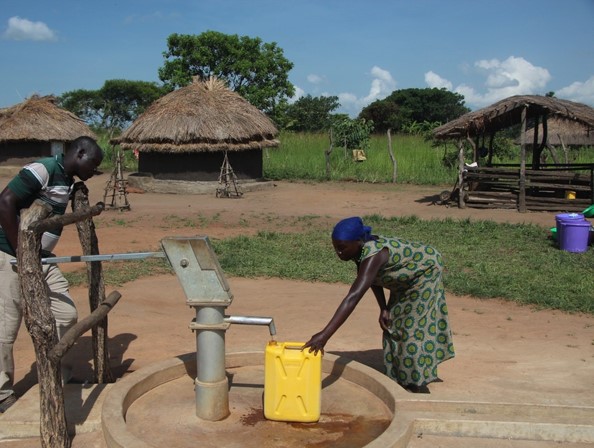
One of the key aspects in the long-term sustainability of any water supply system is the full and enthusiastic involvement of the community in all phases of the water supply process including operation, maintenance and management. The management of a water supply system is interdisciplinary in nature. Hence, operation and maintenance both include structural (i.e. technical) tasks and hygiene/health considerations.
Structural maintenance includes checking the apron for cracks, securing the inspection cover, improving the yield by deepening or removing infiltrated sand particles and the maintenance of the lifting device. Although no skilled worker is required to accomplish these tasks, regularity and accuracy is vital and has to be guaranteed.
Equally, securing hygienic operation is essential. This involves the protection and cleaning of the area (e.g. fencing and covering), checking water quality and disinfecting if necessary, monitoring the effects of withdrawal on environment and surrounding areas, and constantly educating water users in proper operation of the well and in the links of water sanitation and health.
Since groundwater gets physically and biologically filtered as it flows through the soil, water drawn from dug wells is usually of higher quality than surface water and most often safe to drink if not contaminated with geogenic pollution (e.g. arsenic) or cross contamination (e.g. leaching pathogens from unsealed pit-latrines). In order to maintain this quality, solid construction, protection measures and adequate maintenance must be ensured. In this regard, wells should be protected from any contaminants (e.g. solid waste, surface run-off, chemicals, pathogens from latrines, etc.) entering the system by installing a sealing apron and a drainage system. Protection of the surrounding area is equally of importance. Correspondingly, water users need to know and understand operational rules and regulations. Common practices and attitudes could be a threat to any new system, and so to hand-dug wells. Capacity building and awareness raising (see PPT) should therefore be key aspects of any water management project (COLLINS 2000).
| Working Principle | With the prior knowledge that groundwater is present and rather close to the surface, a hole is dug until the groundwater level is reached. Inflowing groundwater is collected and can be extracted with the help of pumps or buckets. |
| Capacity/Adequacy | Particularly in rural areas for small to medium communities. |
| Performance | Depends on geological conditions. Generally higher performance compared to drilled wells. |
| Costs | Very low |
| Self-help Compatibility | High |
| O&M | Simple but vital |
| Reliability | Moderate. Yield may depend on groundwater fluctuations |
| Main strength | Simplicity of the technology |
| Main weakness | Relatively high risk of contamination of the well |
Given suitable geological conditions, (hand-) dug wells provide a low-tech solution to the challenges of rural water supply and can be implemented with a high level of community participation during all phases of the process. They can provide a viable alternative to unhygienic, unprotected water sources while avoiding the capital and maintenance costs associated with more sophisticated water supply systems. A range of different construction types and water lifting technologies can be chosen according to the financial and management capacity of the community. Although dug wells can be constructed with very basic and locally available material and tools, availability of supervision and physically capable workers is important. As for most groundwater sources, dug wells need very careful operation and maintenance to avoid contamination. Protection of the surrounding areas must be ensured in the long-term. Hence, adequate capacity building resources must be available to teach the users how to manage and use the system (COLLINS 2000).
An improvement of existing wells should always be considered as an alternative to the construction of new wells. Often, economical means can be invested more effectively for restoration and hence better optimise the local water management system (UNICEF 1999). Since wells are often sites of cultural, historical or spiritual importance to the community, special attention has to be paid to avoid conflicts and low acceptance (COLLINS 2000).
Hand-dug Shallow Wells
This highly recommended publication comprises everything regarding the establishment of a water supply system based on (shallow) hand-dug wells for communities in the South. It elaborates on the underlying hydrogeological principles, preparatory investigations, design, construction, operation and maintenance, and it discusses the most common mistakes made in design and construction.
COLLINS, S. (2000): Hand-dug Shallow Wells. (= Series of Manuals on Drinking Water Supply , 5 ). St. Gallen: Swiss Centre for Development Cooperation in Technology and Management (SKAT) URL [Visita: 08.03.2019] PDFConstruction of a hand-dug well in Ethiopia
Groundwater, self-supply and poor urban dwellers. A review with case studies of Bangalore and Lusaka
This review explores the extent to which urban dwellers in Bangalore and Lusaka directly and indirectly depend on groundwater. It elaborates on the difficulties they face as a result, and emphasises the need for better integration of groundwater in the planning and management of urban water resources.
GROENWALL, J. MULENGA, M. MCGRANAHAN, G. (2010): Groundwater, self-supply and poor urban dwellers. A review with case studies of Bangalore and Lusaka. (= Human Settlements Working Paper , 24 ). London: International Institute for Environment and Development (IIED) URL [Visita: 15.03.2012] PDFProtected dug well in Gulu (Uganda)
Water from sand-rivers. Water and Sanitation for all: Partnerships and Innovations
Small Community Water Supplies: Technology, People and Partnership: Groundwater Withdrawal - Chapter 10
This book provides a general introduction to a wide range of technologies. Among the topics covered are: planning and management of small water supplies, community water supplies in Central and Eastern European countries, water quality and quantity, integrated water resources management, artificial recharge, rainwater harvesting, spring water tapping, groundwater withdrawal, water lifting, surface water intake, water treatment, aeration, coagulation and flocculation, sedimentation, multi-stage filtration, desalination technology, disinfection, household level water treatment, technologies for arsenic and iron removal from ground water, and emergency and disaster water supply. Chapter 10: Groundwater Withdrawal
SMET, J. ; WIJK, C. van (2002): Small Community Water Supplies: Technology, People and Partnership: Groundwater Withdrawal - Chapter 10. The Hague: International Water and Sanitation Centre (IRC) URL [Visita: 08.03.2019] PDFA Water Handbook
The Water Handbook is the result of wide collaboration within UNICEF. It provides a broad overview of state-of-the-art programming for water management, protection and supply.
UNICEF (1999): A Water Handbook. (= Water, Environment and Sanitation Technical Guidelines , 2 ). New York: United Nations Children’s Fund (UNICEF) URL [Visita: 08.03.2019] PDFTechnology Notes
These technology notes have been prepared following many general enquiries for technical information having been received by WaterAid over the years. Their purpose is to give an outline of the technologies used by WaterAid on long-term development projects in Africa and Asia, and to show alternatives, which might be appropriate in different circumstances. It may be possible to determine from the notes the technology, which would be appropriate in a particular location.
WATERAID (2008): Technology Notes. London: WaterAid URL [Visita: 04.01.2011] PDFHand-dug Shallow Wells
This highly recommended publication comprises everything regarding the establishment of a water supply system based on (shallow) hand-dug wells for communities in the South. It elaborates on the underlying hydrogeological principles, preparatory investigations, design, construction, operation and maintenance, and it discusses the most common mistakes made in design and construction.
COLLINS, S. (2000): Hand-dug Shallow Wells. (= Series of Manuals on Drinking Water Supply , 5 ). St. Gallen: Swiss Centre for Development Cooperation in Technology and Management (SKAT) URL [Visita: 08.03.2019] PDFSmall Community Water Supplies: Technology, People and Partnership: Groundwater Withdrawal - Chapter 10
This book provides a general introduction to a wide range of technologies. Among the topics covered are: planning and management of small water supplies, community water supplies in Central and Eastern European countries, water quality and quantity, integrated water resources management, artificial recharge, rainwater harvesting, spring water tapping, groundwater withdrawal, water lifting, surface water intake, water treatment, aeration, coagulation and flocculation, sedimentation, multi-stage filtration, desalination technology, disinfection, household level water treatment, technologies for arsenic and iron removal from ground water, and emergency and disaster water supply. Chapter 10: Groundwater Withdrawal
SMET, J. ; WIJK, C. van (2002): Small Community Water Supplies: Technology, People and Partnership: Groundwater Withdrawal - Chapter 10. The Hague: International Water and Sanitation Centre (IRC) URL [Visita: 08.03.2019] PDFTechnology Notes
These technology notes have been prepared following many general enquiries for technical information having been received by WaterAid over the years. Their purpose is to give an outline of the technologies used by WaterAid on long-term development projects in Africa and Asia, and to show alternatives, which might be appropriate in different circumstances. It may be possible to determine from the notes the technology, which would be appropriate in a particular location.
WATERAID (2008): Technology Notes. London: WaterAid URL [Visita: 04.01.2011] PDFChlorination for Hand Dug Wells in Peri-urban Monrovia, Liberia
This thesis evaluated various well chlorination systems and assessed the need for chlorination training and awareness raising in peri-urban Monrovia communities.
GARANDEAU, R. (2004): Chlorination for Hand Dug Wells in Peri-urban Monrovia, Liberia. Cranfield: Cranfield University at Silsoe URL [Visita: 08.03.2019] PDFBasic Ground-Water Hydrology
A basic textbook that comprises various aspects of groundwater hydrology. Amongst others, the hydrologic cycle, groundwater flow, well and aquifer tests, well pollution and well protection.
HEATH, R.C. (1987): Basic Ground-Water Hydrology. Reston: United States Geological Survey (USGS) URL [Visita: 15.03.2012] PDFUpgrading Traditional Wells
Wells have been used to obtain water since ancient times. Some wells have been in continuous use for hundreds of years. Others are fairly new, but have been built by traditional methods. Good water quality can usually be obtained from a well that is properly constructed, maintained, and used. Some traditional wells are excellent. Others are not and need upgrading.
PICKFORD, J. (1990): Upgrading Traditional Wells. Leicestershire: WEDC, Loughborough University URL [Visita: 08.03.2019] PDFA Water Handbook
The Water Handbook is the result of wide collaboration within UNICEF. It provides a broad overview of state-of-the-art programming for water management, protection and supply.
UNICEF (1999): A Water Handbook. (= Water, Environment and Sanitation Technical Guidelines , 2 ). New York: United Nations Children’s Fund (UNICEF) URL [Visita: 08.03.2019] PDFSocial adoption of groundwater pumping technology and the development of groundwater cultures. Governance at the point of abstraction
This thematic paper examines the historic and ongoing development of water lifting technologies and the governance problems and solutions that have arisen from controlled or uncontrolled groundwater abstraction. It also examines legislation to improved pump efficiency and the economics and life cycle costing of borehole pumps.
FAO GEF IAH IHP World Bank (2012): Social adoption of groundwater pumping technology and the development of groundwater cultures. Governance at the point of abstraction. FAO URL [Visita: 08.04.2013] PDFCleaning Hand Dug Wells
Flooding, earthquakes, civil unrest and other natural and man-made disasters often cause damage to hand-dug wells. This technical note sets out the actions needed to repair and rehabilitate a hand-dug well so that it can be returned to its former condition.
GODFREY, S. REED, B. (2013): Cleaning Hand Dug Wells. (= Technical Notes on Drinking-Water, Sanitation and Hygiene in Emergencies , 1 ). Geneva: World Health Organization (WHO) URL [Visita: 26.08.2013] PDFCleaning Wells after Seawater Flooding
Many people living in coastal regions rely on shallow groundwater for their water supply. Seawater flooding after a severe storm or tsunami can damage wells and contaminate the groundwater. This technical note provides advice for rehabilitating wells in such circumstances. It should be used in conjunction with Technical Note 1 which provides general information about rehabilitating wells after a disaster.
VILHOLTH, K. (2013): Cleaning Wells after Seawater Flooding. Technical Notes on WASH in Emergencies #15. Geneva: World Health Organization (WHO) URL [Visita: 11.03.2019] PDFGroundwater, self-supply and poor urban dwellers. A review with case studies of Bangalore and Lusaka
This review explores the extent to which urban dwellers in Bangalore and Lusaka directly and indirectly depend on groundwater. It elaborates on the difficulties they face as a result, and emphasises the need for better integration of groundwater in the planning and management of urban water resources.
GROENWALL, J. MULENGA, M. MCGRANAHAN, G. (2010): Groundwater, self-supply and poor urban dwellers. A review with case studies of Bangalore and Lusaka. (= Human Settlements Working Paper , 24 ). London: International Institute for Environment and Development (IIED) URL [Visita: 15.03.2012] PDFGroundwater Suitability for Irrigation. A Case Study from Debre Kidane Watershed, Eastern Tigray, Ethiopia
The paper assesses groundwater suitability for irrigation purposes in Debre Kidane Watershed in northern Ethiopia.
TADESSE, N. BHEEMALINGESWARA, K. BERHANE, A. (2009): Groundwater Suitability for Irrigation. A Case Study from Debre Kidane Watershed, Eastern Tigray, Ethiopia. Mekelle: Mekelle University URL [Visita: 15.03.2012] PDFSelf-Supply as a Complementary Water Services Delivery Model in Ethiopia
Self-supply, where households invest to develop their own easily-accessible water supplies, is identified as an alternative service delivery model that is potentially complementary to more highly subsidised community-level provision. The approach is widespread in Ethiopia with family wells bringing additional benefits that are in line with wider government objectives, such as supporting small-scale irrigation. However, two recent studies show the current performance of traditional or family wells to be far below potential with most sources providing unsafe water in the absence of adequate protection.
BUTTERWORTH, J. ; SUTTON, S. ; MEKONTA, L. (2013): Self-Supply as a Complementary Water Services Delivery Model in Ethiopia. Entradas: Water Alternatives: Volume 6 , 405-423. URL [Visita: 08.03.2019] PDFWell Digging - A Guide to the Construction and Protection of Hand Dug Wells
This book is written in a non-technical language and elaborates on the construction of a shallow well, its protection, and the improvement of a traditional well.
LAVER, S. (1970): Well Digging - A Guide to the Construction and Protection of Hand Dug Wells. Eschborn: Deutsche Gesellschaft fuer Internationale Zusammenarbeit (GIZ) URL [Visita: 08.03.2019] PDFUpgraded Well Manual for Field Workers
This field manual brings together knowledge of the technique of upgrading simple shallow wells. The simple technique of upgrading simple shallow wells has been investigated and tested by staff of the Blair Research Laboratory and subsequently by staff of the Mvuramanzi Trust for many years. It is now well established in many areas of Zimbabwe.
MORGAN, P. (1995): Upgraded Well Manual for Field Workers. Harare: Mvuramanzi Trust URL [Visita: 08.03.2019] PDFThe Upgraded Family Well. How to Construct
Where access to construction material, tool and skills are limited, construction has to get on with simple and effective measures. This nicely illustrated manual explains how to upgrade small wells by means of constructing a concrete apron using only basic material and very limited equipment.
MORGAN, P. (2011): The Upgraded Family Well. How to Construct. Harare: Aquamor Pvt Ltd. URL [Visita: 08.03.2019] PDFRepairing, Cleaning and Disinfection Hand Dug Wells. OXFAM Technical Briefs
Hand dug wells may need repairing, cleaning and disinfecting after inundation by flood- or seawater or after long periods of insufficient maintenance. This Technical Brief elaborates on the process of repairing; cleaning and disinfecting hand dug wells and also discusses the OXFAM kits, which can be used for this purpose.
OXFAM (n.y): Repairing, Cleaning and Disinfection Hand Dug Wells. OXFAM Technical Briefs. Washington D.C.: Oxfam International Advocacy URL [Visita: 08.03.2019] PDFDrainage from Water Points
This poster is part of the series of Water, Sanitation and Hygiene posters designed by the Water, Engineering and Development Center of Loughborough University.
SKINNER, B.H. CHATTERTON, K. SHAW, R. (2013): Drainage from Water Points. Poster. (= WEDC Posters , 7 ). London: Water, Engineering and Development Center (WEDC) URL [Visita: 28.08.2013] PDFA Water Handbook
The Water Handbook is the result of wide collaboration within UNICEF. It provides a broad overview of state-of-the-art programming for water management, protection and supply.
UNICEF (1999): A Water Handbook. (= Water, Environment and Sanitation Technical Guidelines , 2 ). New York: United Nations Children’s Fund (UNICEF) URL [Visita: 08.03.2019] PDFWHYMAP project
The Web Map Application aims at visualising hydrogeological information collected within the WHYMAP project on a global scale. For more regional or country level interest, additional information on available hydrogeological maps is provided.



